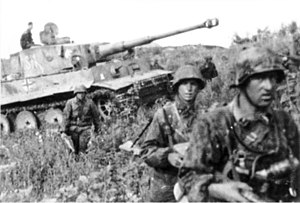The Kursk Bulge
| Battle of Kursk | |||||||||
|---|---|---|---|---|---|---|---|---|---|
| Part of the Eastern Front of World War II | |||||||||
 2nd SS Panzer Division soldiers, Tiger I tank, during the battle |
|||||||||
|
|||||||||
| Belligerents | |||||||||
|
|
|
||||||||
| Commanders and leaders | |||||||||
| Strength | |||||||||
|
|
||||||||
| Casualties and losses | |||||||||
|
|
||||||||
|
|
|||||||||
Strategic Soviet victory
The Battle of Kursk was a Second World War engagement between German and Soviet forces on the Eastern Front near Kursk (450 kilometres or 280 miles south-west of Moscow) in the Soviet Union during July and August 1943. The German offensive was code-named Operation Citadel (German: Unternehmen Zitadelle) and led to one of the largest armoured clashes in history, the Battle of Prokhorovka. The German offensive was countered by two Soviet counter-offensives, Operation Polkovodets Rumyantsev (Russian: Полководец Румянцев) and Operation Kutuzov (Russian: Кутузов). For the Germans, the battle was the final strategic offensive that they were able to launch on the Eastern Front. Their extensive loss of men and tanks ensured that the victorious Soviet Red Army enjoyed the strategic initiative for the remainder of the war.
The Germans hoped to weaken the Soviet offensive potential for the summer of 1943 by cutting off a large number of forces that they anticipated would be in the Kursk salient. The Kursk salient or bulge was 250 kilometres (160 mi) long from north to south and 160 kilometres (99 mi) from east to west. The plan envisioned an envelopment by a pair of pincers breaking through the northern and southern flanks of the salient.Adolf Hitler believed that a victory here would reassert German strength and improve his prestige with his allies, who were considering withdrawing from the war. It was also hoped that large numbers of Soviet prisoners would be captured to be used as slave labour in the German armaments industry.
...
Wikipedia

